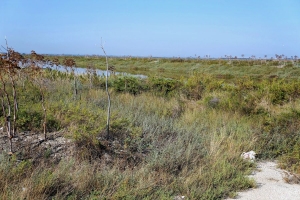

 +12Kontinente:EUAS
+12Kontinente:EUAS1. Lebendfotos
1.1. Falter
2. Diagnose
2.1. Männchen
2.2. Weibchen
2.3. Geschlecht nicht bestimmt
2.4. Genitalien
2.4.1. Weibchen
2.5. Erstbeschreibung
3. Biologie
3.1. Habitat
3.2. Nahrung der Raupe
- [Poaceae:] Cynodon dactylon (Gewöhnliches Hundszahngras)
- [Cyperaceae:] Cyperus rotundus (Knolliges Zypergras, Nussgras, Orientalische Cyperwurzel, Runde Cyperwurzel)
- [Cyperaceae:] Cyperus sp. (Zypergras)
- [Solanaceae:] Capsicum annuum (Spanischer Pfeffer, Paprika)
Meyrick (1922: 521) erläutert in seiner Erstbeschreibung von Bactra graminivora: "Bengal, Pusa, bred April to June from larvae mining stems of Cynodon dactylon (Gramineae) (Fletcher) 12 ex. [...]". Etwas stutzig macht hier nur, dass dort zeitgleich Falter einer weiteren Art aus diesem Gras geschlüpft sein sollen, die in Europa fehlende Bactra commensalis Meyrick, 1922. Meyrick (1922: 522) erläutert dazu: "This species and graminivora were bred together from the same material, and as both are variable and similar were at first very perplexing; but Mr. Fletcher kindly and wisely forwarded me the whole of the examples bred for examination, and also fortunately sent with most of the specimens the pupal cases; I was thus enabled to satisfy myself of their distinctness. No species of this difficult genus has hitherto been reared from a grass."
Cynodon dactylon ist im Mittelmeerraum verbreitet, ist in Europa aber auch weit über das Verbreitungsgebiet des Falters hinaus stellenweise in Mitteleuropa zu finden; so machte sich die Art in den letzten Jahrzehnten besonders auf warmen Sanden am Nördlichen Oberrhein breit.
Die Art wurde häufiger mit Zyperngras (Cyperus) in Verbindung gebracht. Die Angabe zu Cyperus rotundus stammt nach [http://www.tortricidae.com/foodplants_by_species.pdf] dabei von Trematerra & Baldizzone (2004: 35) und sollte auf einer Beobachtung aus Kroatien beruhen. Das stimmt nicht, denn in der Arbeit wird nur auf den Erstfund eines Falters aus Kroatien berichtet und bezüglich der Biologie auf die Arbeit von Trematerra & Ciampolini (1989) aus Italien verwiesen.
Roditakis et al. (2016) überraschen mit einem Artikel "Is Bactra bactrana (Kennel, 1901) a novel pest of sweet peppers?", in dem von Schäden an Paprika (Capsicum annuum) berichtet wird. Sie schließen daraus, dass man doch vorsichtiger sein sollte, Bactra-Falter zur Bekämpfung von Cyperus-Unkräutern einzusetzen.
Die "North American Plant Protection Organization" fasst in ihrem [Phytosanitary Alert System] die Ergebnisse des Artikels zusammen: "In 2014, Bactra bactrana (Lepidoptera: Tortricidae) larvae were found infesting Capsicum annuum (pepper) fruits in two greenhouses in the Greek island of Crete. Multiple small holes were observed on infested fruits, and internal feeding resulted in extensive tissue damage, dark discoloration, and yield losses. This is the first report of C. annuum as a host of B. bactrana (Roditakis et al., 2015). Bactra bactrana was previously only known to be a stem borer of Cyperaceae and Poaceae (Brown et al., 2008; Roditakis et al., 2015). The factors influencing the tortricid shift to peppers are currently unknown."
(Autor: Erwin Rennwald)
4. Weitere Informationen
4.1. Andere Kombinationen
- Semasia bactrana Kennel, 1901 [Originalkombination]
4.2. Synonyme
- Bactra graminivora Meyrick, 1922
- Bactra mediterraneana Agenjo, 1952
- Bactra cyperana Amsel, 1952
4.3. Publikationsdatum der Erstbeschreibung
Nach der Fußnote der „Inhalts-Uebersicht“ [Digitalisat auf biodiversitylibrary.org] ist Heft 1 mit den Seiten 1-160 und den Tafeln I-IV am 15. August 1900 erschienen und Heft 2 mit den Seiten 161-362 und den Tafeln V-VIII am 20. Februar 1901.
(Autor: Jürgen Rodeland)
4.4. Literatur
- Erstbeschreibung: Kennel, J. (1901): Neue Wickler des palaearctischen Gebietes aus den Sammlungen der Herren O. Staudinger und A. Bang-Haas. — Deutsche Entomologische Zeitschrift Iris 13 (2): 205-305.
- Beschreibung als Bactra graminivora: Meyrick, E. (1922): Exotic Microlepidoptera 2 (17): 513-544. [London] (Taylor & Francis).
- Roditakis, E., Morin, S. & J. Baixeras (2016): Is Bactra bactrana (Kennel, 1901) a novel pest of sweet peppers? — Bulletin of Entomological Research, 106 (2): 161-167. [Sekundärzitat nach dem Abstract auf [cambridge.org]]
- Trematerra, P. & G. Baldizzone (2004): Records of Tortricidae (Lepidoptera) from Krk Island (Croatia). — Entomologia Croatica, 8: 25-44. [PDF auf hrcak.srce.hr]
- Trematerra, P. & M. Ciampolini (1989): Il genere Bactra Stephens (Lepidoptera Tortricidae) nella biocenosi di Cyperus rotundus L. in Italia. — Bollettino di Zoologia Agraria e di Bachicoltura, 21: 7-26. [Sekundärzitat]





























